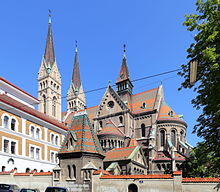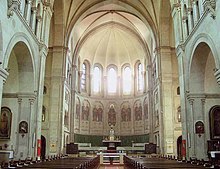Canisius Church (Vienna)
The Canisius Church is a Roman Catholic parish in the 9th Viennese district of Alsergrund . It was built towards the end of the 19th century according to plans by Gustav Ritter von Neumann in the style of historicism and inaugurated in 1903 in the presence of Emperor Franz Joseph . With a tower height of 85 meters, it is the fourth highest church in Vienna and the tallest building on the Alsergrund. The attached parsonage - today a student residence - served the Jesuits as a religious house and is still in their property today.
history
On the 4th Austrian Catholic Day in 1896, the Marian Merchants Congregation, founded in 1890, proposed that a worthy memorial should be erected to the then Blessed Petrus Canisius , court preacher , episcopal vicar and administrator of the Diocese of Vienna from 1554 to 1555 , on the 300th anniversary of his death. On November 15, 1897, the Canisius Church Building Association was constituted and placed itself under the patronage of Archduchess Maria Josepha . After the building was approved by the city council on July 23, 1899, construction began on July 31, 1899, the feast of St. Ignatius of Loyola . The solemn laying of the foundation stone on October 15 was carried out by the Apostolic Field Vicar Coloman Belopotoczky , while Archduke Ferdinand Carl appeared on behalf of the Emperor . After four years of construction, the church was consecrated on October 18, 1903 by the auxiliary bishops Johann Baptist Schneider , Godfried Marschall and the Hofburg priest, Bishop Laurenz Mayer . At the first mass that followed, Emperor Franz Joseph and several members of the imperial family and numerous other guests took part.
Since Petrus Canisius was only beatified but not canonized at this point in time, the consecrated titles The Suffering Savior on the Mount of Olives and The Sorrowful Mother of God Mary were chosen. After Petrus Canisius was canonized in 1925 and made a Doctor of the Church, the way was clear to have him declared the main patron of the Canisius Church by a decree of the Congregation for Rites. In 1939 the Canisius Church became a place of worship for the newly founded parish of the same name.
Building
The upper church was designed by the architect Gustav Ritter von Neumann in a style combination of neo-Romanesque and neo-Gothic. With its two 85 meter high facade towers, it dominates the Himmelpfortgrund as the fourth highest church in Vienna . The coats of arms of the most important donors are attached to the towers. A wide flight of stairs leads to the church portal, above whose gable there is a statue of Petrus Canisius . In the side niches there is St. Ignatius and on the right St. Franz Xaver . These larger than life figures were created by Franz Barwig .
The spacious interior, a wide, high hall, presents itself as a nave with a clear transept, with three chapel niches left open on both sides. The decor shows typical early Gothic forms.
The presbytery was rebuilt in gray marble as part of the overall renovation carried out in 1956 according to plans by Ladislaus Hruska . Instead of the former altarpiece "Christ on the Mount of Olives", a mosaic of the twelve apostles depicted in pairs now adorns the apse wall, for which Heinrich Tahedl provided the template. Erwin Klobassa designed the tabernacle , the two ambones are from Josef Papst . In the ambulatory, in seven niches on originally preserved wall paintings, the Seven Sorrows of Mary are depicted in rich colors. The vaulted ceiling is also decorated with ornaments and heraldry. The Habsburg house coat of arms, repeated in many variants, indicates the numerous donors from all lines of the imperial family. The two-storey choir in the nave bears the family emblem of the House of Habsburg-Lothringen in addition to the Viennese and Lower Austrian coats of arms .
The stained glass windows are by Hans Schock and show Saints Stephen and Thomas , the archangels Michael and Raphael , St. Franz Xavier and St. Barbara , the Apostles Peter and Paul , Saints Aloisius Gonzaga and Stanislaus Kostka , St. Laurentius and St. Agnes of Rome and the Holy Family in the ambulatory .
Most of the tables on the side altars were adapted to the new overall style and clad with marble. The old altarpieces by Heinrich Reinhart (1903) were preserved, as were the stained glass windows by the Tyrolean Hans Schock.
The niche paintings with column men are on the left of St. Joseph , St. Guardian Angel and St. Jude Thaddeus , on the right side St. Ignatius , the hl. Petrus Canisius and St. Consecrated to Johannes Nepomuk . The founder of the order shows the Jesuit motto OAMDG (Omnia ad maiorem Dei gloriam / Everything for the greater glory of God). The namesake of the church holds a catechism in his hand, at his feet you can see Viennese children and in the background St. Stephen's Cathedral . The Infant Jesus of Prague stands in a shrine in front of the image of the bridge saint .
The spacious crypt , built in neo-Romanesque forms, was set up as a chapel and meeting room for various Marian congregations and was dedicated to the Blessed Virgin Mary, mistress and protector of the sodals . The altar, a foundation of the men's congregation at the university church in the 1st district, bears the large stone group Homage of the Sodals in front of the Queen of Heaven by Franz Barwig the Elder (1902).
Canisiushaus student residence
At the same time as the church was built, a parsonage and religious house with a cloister was built, which is still owned by the Jesuit order . Since a general renovation and refurbishment in 2015, the listed building on Canisiusgasse has been home to a student residence run by the Catholic student support association Akademikerhilfe , founded in 1921 .
Church life
The parish Canisius is located in the Vicariate City of the Archdiocese of Vienna in City Deanery 8/9. It also offers a location for African-Francophone, Japanese, Brazilian and Indonesian communities, and here is also a Caritas Vienna Le + O distribution point , where food is distributed to people at risk of poverty.
literature
- Karl Koloman Schlesinger: The Canisius Church in Vienna. Festschrift for the solemn inauguration of the foundation stone on October 15, 1899 . Vienna 1899
- The Canisius Church in Vienna. A monument in honor of Blessed Petrus Canisius . Canisiushaus, Vienna 1903
- Eduard Fischer (ed.): The Vienna Canisius Church in pictures . Canisius Church Building Association, Vienna around 1910
Individual evidence
-
^ The program of the Canisius celebration organized by the Fest-Comité… In: Ordinariats-Blatt der Budweiser Diöcese , January 27, 1897, p. 3.
The Austrian Canisius celebration. In: Reichspost , November 17, 1897, p. 4 (online at ANNO ). - ↑ Construction news. Vienna. Church building. In: Der Bautechniker , August 4, 1899, p. 681 (online at ANNO ).
-
↑ Church State and School - Ceremonial laying of the foundation stone for Canisius Church. In: Reichspost , October 6, 1899, pp. 9-10 (online at ANNO ). * [The laying of the foundation stone of the Canisius Church . ] In: Deutsches Volksblatt. Morning edition , October 11, 1899, p. 4 (online at ANNO ). Viennese toasts. Reports on the laying of the foundation stone for the Canisius Jubilee Church. In: Das Vaterland , October 17, 1899, pp. 2–3 (online at ANNO ).
-
↑ The dedication of the Canisius Church. In: Wiener Abendpost. Supplement to Wiener Zeitung , October 10, 1903, p. 1 (online at ANNO ). The consecration of the Canisius Church. The emperor in the new church. In: Illustrirtes Wiener Extrablatt , October 19, 1903, p. 1 (online at ANNO ). The consecration of the Canisius Church. In: Illustrirtes Wiener Extrablatt , October 19, 1903, p. 4 (online at ANNO ).
- ^ Parish Canisius: Parish Canisius> Parish history> Parish chronicle. (No longer available online.) In: www.pfarre-canisius.at. Archived from the original on September 16, 2016 ; accessed on September 12, 2016 . Info: The archive link was inserted automatically and has not yet been checked. Please check the original and archive link according to the instructions and then remove this notice.
- ^ Canisius Church in the Vienna History Wiki of the City of Vienna
- ↑ Akademikerhilfe web editor: Akademikerhilfe: opening round. In: www.akademikerhilfe.at. Retrieved September 12, 2016 .
- ^ Archdiocese of Vienna, Canisius Church. Retrieved June 16, 2019 .
- ^ Caritas Vienna, Food and Orientation, Issuing Points. Retrieved June 16, 2019 .
Web links
Coordinates: 48 ° 13 ′ 43 ″ N , 16 ° 21 ′ 6 ″ E




